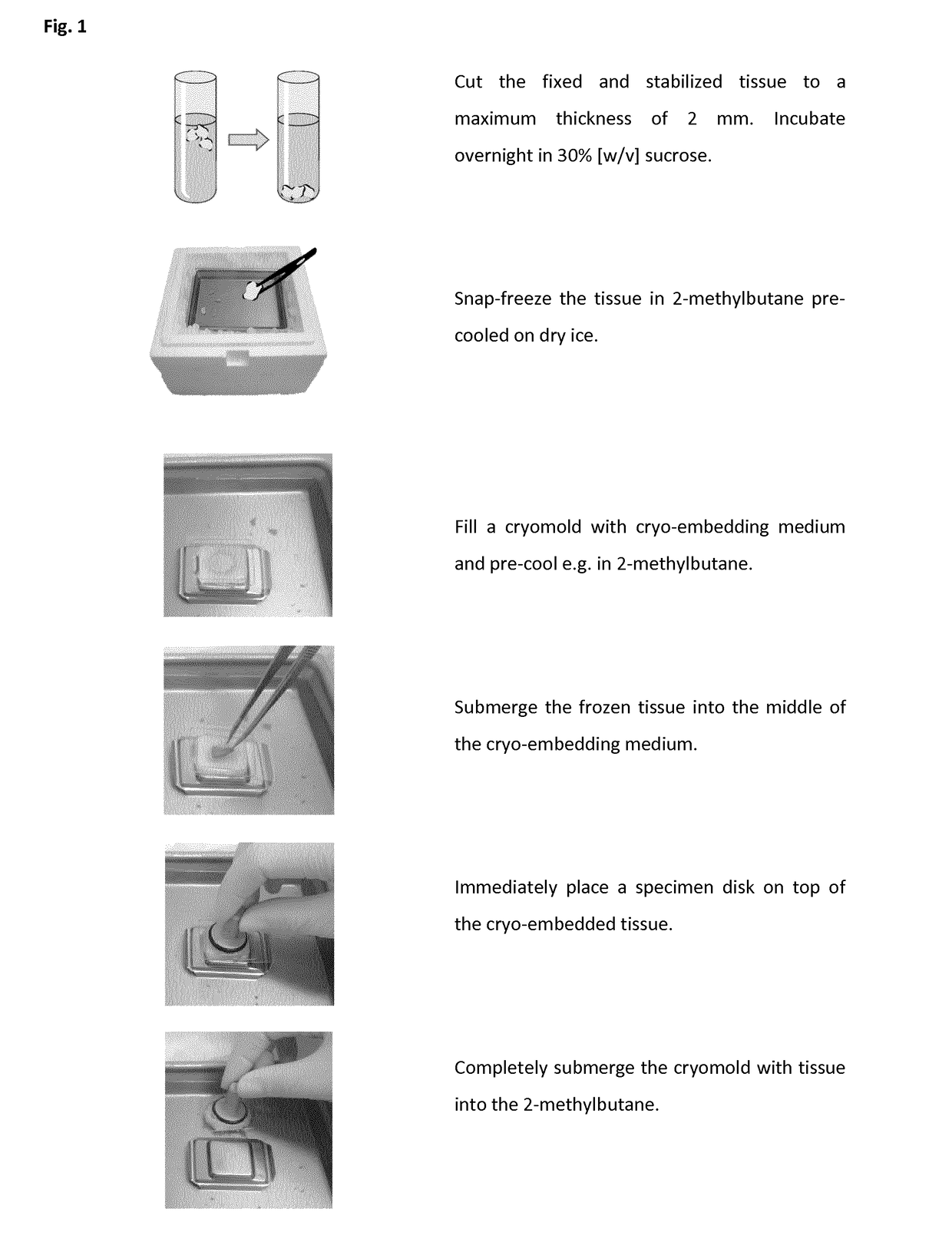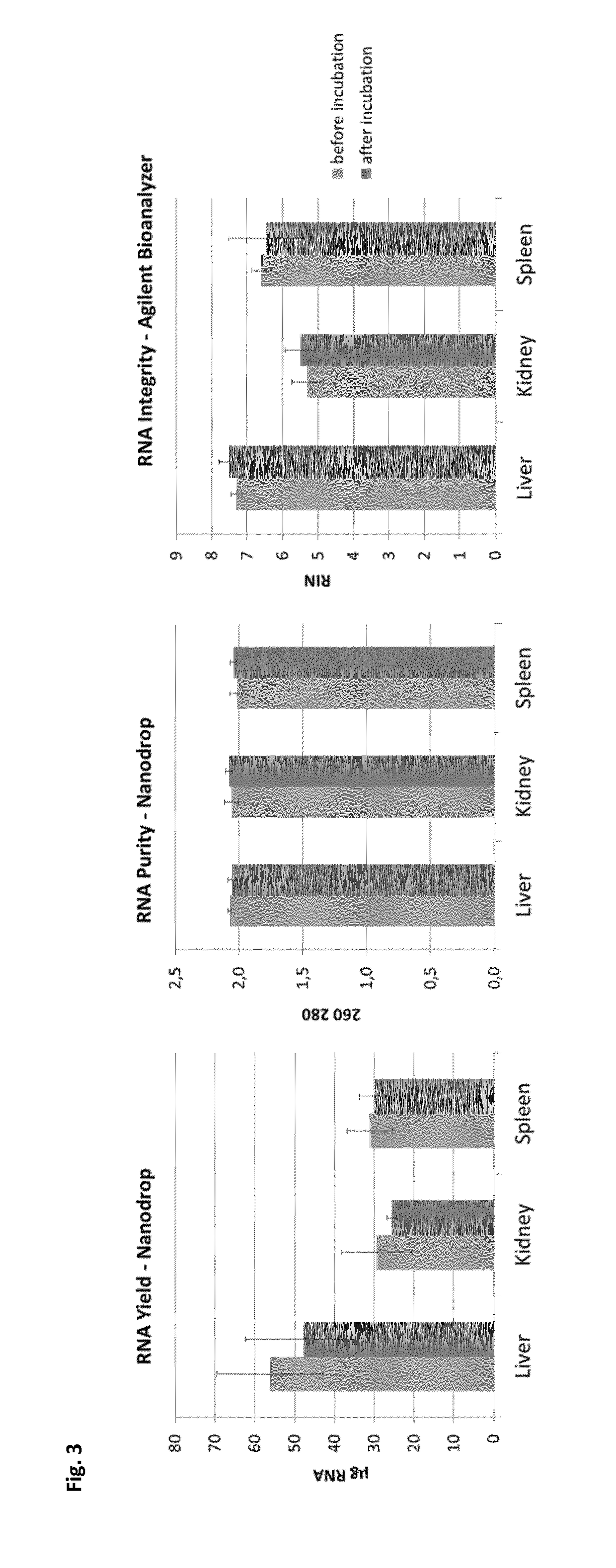Method of preparing a frozen biological sample
a biological sample and sample technology, applied in the field of preparation of frozen biological samples, can solve the problems of severe chemical modification and degradation of biomolecules, laborious methods, and purification of biological components, and achieve the effects of high quality, high quality and preservation of sample morphology
- Summary
- Abstract
- Description
- Claims
- Application Information
AI Technical Summary
Benefits of technology
Problems solved by technology
Method used
Image
Examples
example 1
1. Example 1
[0477]RNA Extraction from PAXgene Tissue Fixed and Stabilized Tissue with or without Cryo-Protection by Incubation in Sucrose Solution
[0478]Duplicate samples of rat liver, kidney and spleen samples with a maximum thickness of 4 mm were fixed and stabilized with the PAXgene Tissue FIX and STABILIZER reagents according to the handbook. One sample from each tissue type was transferred to 30% (w / v) sucrose solution (prepared by dissolving 30 g sucrose in 100 ml of water) for 12 hours incubation at 4° C. The other tissue sample was kept within the PAXgene Tissue STABILIZER.
[0479]FIG. 3 shows RNA yield, purity and integrity from fixed and stabilized tissue with or without incubation in 30% sucrose solution. RNA was extracted in duplicates from 10mg of tissue from each sample using consumables of the PAXgene Tissue RNA kit.
[0480]Conclusions
[0481]RNA yield, purity and integrity is not significantly different between fixed and stabilized tissue with or without cryo-protection.
[04...
example 2
2. Example 2
[0483]RNA Extraction from Sections of PFCE Tissue, Snap-Frozen in 2-Methylbutane and Mounted on Slides
[0484]Rat liver, kidney, spleen, intestine, lung, heart muscle, cerebrum and esophagus samples with a maximum thickness of 4 mm were fixed and stabilized with the PAXgene Tissue FIX and STABILIZER reagents according to the handbook. Fixed and stabilized tissue were grossed to 2 mm thickness and incubated in 30% (w / v) sucrose solution for 12 hours at 4° C. Samples were snap-frozen in cooled 2-methylbutane followed by cryo-embedding. Sections with 12 μm thickness were mounted on slides and total RNA was purified from the sections with consumables from the PAXgene Tissue RNA kit.
[0485]FIG. 4 shows RNA yield, purity and integrity from PFCE sections mounted on slides. RNA was extracted in duplicates from 12 μm PFCE sections mounted on slides using consumables of the PAXgene Tissue RNA kit.
[0486]Conclusion
[0487]High-quality RNA can be isolated from sections of PFCE tissue moun...
example 3
3. Example 3
[0488]RNA Extraction from Sections of PFCE Tissue, Snap-Frozen in Liquid Nitrogen, Directly Transferred into Microcentrifuge Tubes
[0489]Rat intestine, lung, heart muscle, cerebrum and esophagus samples with a maximum thickness of 4 mm were fixed and stabilized with the PAXgene Tissue FIX and STABILIZER reagents according to the handbook. Fixed and stabilized tissue were grossed to 2 mm thickness and incubated in 30% (w / v) sucrose solution for 12 hours at 4° C. Samples were simultaneously snap-frozen and cryo-embedded in liquid nitrogen. Sections of PFCE blocks with 10 μm thickness were transferred into microcentrifuge tubes and purified with consumables from the PAXgene Tissue RNA kit.
[0490]FIG. 5 shows RNA yield, purity and integrity from PFCE sections transferred into a microcentrifuge tube. RNA was extracted in triplicates from 3 sections of PFCE tissue blocks, snap-frozen in liquid nitrogen, with 10 μm thickness each. Sections were directly transferred into a microce...
PUM
 Login to View More
Login to View More Abstract
Description
Claims
Application Information
 Login to View More
Login to View More - R&D
- Intellectual Property
- Life Sciences
- Materials
- Tech Scout
- Unparalleled Data Quality
- Higher Quality Content
- 60% Fewer Hallucinations
Browse by: Latest US Patents, China's latest patents, Technical Efficacy Thesaurus, Application Domain, Technology Topic, Popular Technical Reports.
© 2025 PatSnap. All rights reserved.Legal|Privacy policy|Modern Slavery Act Transparency Statement|Sitemap|About US| Contact US: help@patsnap.com



